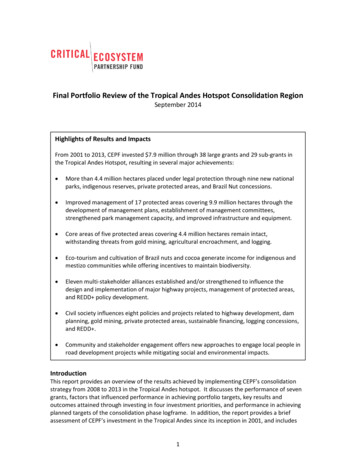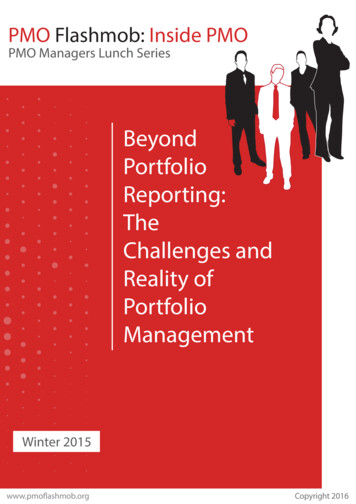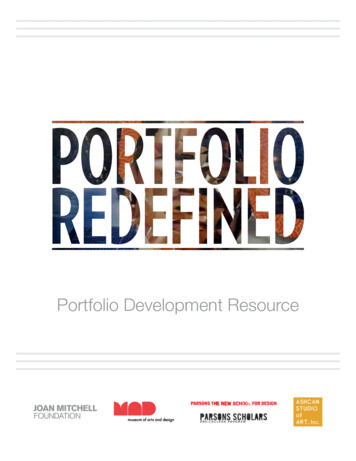
Transcription
Final Portfolio Review of the Tropical Andes Hotspot Consolidation RegionSeptember 2014Highlights of Results and ImpactsFrom 2001 to 2013, CEPF invested 7.9 million through 38 large grants and 29 sub‐grants inthe Tropical Andes Hotspot, resulting in several major achievements: More than 4.4 million hectares placed under legal protection through nine new nationalparks, indigenous reserves, private protected areas, and Brazil Nut concessions. Improved management of 17 protected areas covering 9.9 million hectares through thedevelopment of management plans, establishment of management committees,strengthened park management capacity, and improved infrastructure and equipment. Core areas of five protected areas covering 4.4 million hectares remain intact,withstanding threats from gold mining, agricultural encroachment, and logging. Eco‐tourism and cultivation of Brazil nuts and cocoa generate income for indigenous andmestizo communities while offering incentives to maintain biodiversity. Eleven multi‐stakeholder alliances established and/or strengthened to influence thedesign and implementation of major highway projects, management of protected areas,and REDD policy development. Civil society influences eight policies and projects related to highway development, damplanning, gold mining, private protected areas, sustainable financing, logging concessions,and REDD . Community and stakeholder engagement offers new approaches to engage local people inroad development projects while mitigating social and environmental impacts.IntroductionThis report provides an overview of the results achieved by implementing CEPF’s consolidationstrategy from 2008 to 2013 in the Tropical Andes hotspot. It discusses the performance of sevengrants, factors that influenced performance in achieving portfolio targets, key results andoutcomes attained through investing in four investment priorities, and performance in achievingplanned targets of the consolidation phase logframe. In addition, the report provides a briefassessment of CEPF’s investment in the Tropical Andes since its inception in 2001, and includes1
the status of progress in Bolivia and Peru toward meeting CEPF’s long‐term conservation goals.The data and conclusions are based on a review grant final reports, a bi‐national workshop withgrantees in Puerto Maldonado, Peru in 2012, and discussions in La Paz and Lima with senior staffworking on CEPF projects since 2001.BackgroundKnown as the “Global Center of Biodiversity,” the Tropical Andes biodiversity hotspot is the mostdiverse region on the planet in terms of species endemism and richness. The hotspot stretchesalong the eastern slopes of the Andes from northwest Venezuela to the northwest corner ofArgentina, covering 150 million hectares, roughly the size of Iran. It is shaped by steep slopesbetween snow‐capped peaks, complex valleys, and a piedmont zone above 500 meters. Below isthe vast wilderness of Amazon rain forest to the east, and the Tumbes‐Chocó‐Magdalena hotspotto the northwest.CEPF Investment from 2001 ‐ 2006The Tropical Andes was among the first three regions selected by CEPF to receive funding, from2001 to 2006. CEPF and its partners adopted an ambitious landscape‐scale agenda that called forstrengthening the Vilcabamba‐Amboró Corridor, a 30‐million hectare swath of forest containing16 large protected areas in Bolivia and Peru, shown in Figure 1. CEPF’s investment strategy wasdeveloped through two multi‐stakeholder workshops where consensus emerged on the need tocreate a mega‐corridor for management as a cohesive and integrated unit, to be characterized bya mosaic of protected areas and reserves under sustainable management. To achieve this vision,Figure 1. CEPF Investment GeographyTropical Andes HotspotVilcabamba Amboro Conservation Corridor2
CEPF aimed to expand coverage of protected areas; strengthen management in existing areas;reduce threats, particularly from colonization, logging, agricultural encroachment, and mining;and achieve greater coordination between various stakeholders.CEPF Consolidation PhaseAlthough many important objectives were achieved, several significant threats remained and newones emerged. Under the South American Infrastructure Integration Initiative (IIRSA), the corridorstarted to undergo dramatic change, as road, petroleum, mining, hydroelectric, canalization, andother infrastructure projects expanded their operations significantly. Two roads approved forconstruction ‐‐ the Southern Inter‐Oceanic Highway in Peru and the Northern Corridor Highway inBolivia – spurred great controversy due to the potential threats that would ensue in the corridor.The Inter‐Oceanic Highway would be the first paved roadway connecting the Atlantic and Pacificoceans in South America. While many economic opportunities were expected to arise, roadupgrading also could fuel migration, deforestation, land invasion and speculation, hunting andmining. Given these challenges, CEPF approved the consolidation program to target high priorityneeds in the Tambopata ‐ Pilón Lajas sub‐corridor to mitigate the expected threats from roadupgrading.CEPF embarked on a consolidation phase in 2008 with an approved budget of 2.185 million. Theconsolidation strategy aimed to address high priority needs in the eight protected areasconsidered to be most vulnerable to the potential threats from the new roads. It contained fourmutually‐dependent investment priorities:1. Support civil society participation in development planning and implementation for theVilcabamba‐Amboró Conservation Corridor, focusing on the Southern Inter‐Oceanic andNorthern Corridor highways.2. Support management improvements to mitigate the adverse impacts arising fromimproved road access in the eight most vulnerable protected areas.3. Support the establishment of sustainable financing mechanisms.4. Support productive projects that maintain forest cover in areas of strategic value forcorridor‐level connectivity.Portfolio StatusThe consolidation phase was implemented from November 2008 to July 2013. Funding wascommitted to seven projects, as presented in Table 1. Of the 2.185 million contracted, only 27,528 was unspent (see Annex 1).Similar to CEPF’s strategy during its first investment phase, the consolidation portfolio joinedforces with three national conservation funds in Peru and Bolivia to achieve a 1:1 match forimplementing 14 sub‐grants to community‐based organizations: Fondo de las Americas del Peru(FONDAM), Fundación Para El Desarrollo Del Sistema Nacional de Áreas Protegidas (FUNDESNAP)in Bolivia, and Fundación Protección y Uso Sostenible del Medio Ambiente (PUMA) in Bolivia.As with all consolidation programs, contracting and portfolio management was conducted by theCEPF Secretariat.3
Table 1 – Overview of Tropical Andes Consolidation GrantsAmountSpentOrganizationTitleAsociación para la Investigación yDesarrollo Integral, Perú (AIDER)Conservation International (CI) –Bolivia and PeruSubgrantees:- La Molina AgriculturalUniversity – ConservationData Center.Preparing Peru’s Madre de DiosRegion for REDD Fostering Stakeholder Collaborationand Monitoring the Impacts and theConservation Actions AroundInfrastructure Projects in theVilcabamba‐Amboró ConservationCorridor 198.812Fondo de las Américas del Perú(FONDAM), PeruStrengthening Connectivity AlongPeru’s Inter‐Oceanic Highway inMadre de Dios through theSustainable Use of NaturalResources and EconomicDevelopment (FONDAM II)1Subgrantees:- Conservación Ambiental yDesarrollo en el PerúCAMDE)- Asociación Caritas Madre deDios,- Asociación AgriculturaEcológica (AAE)- Asociación para el DesarrolloEconómico y Social del Agro– ACCION AGRARIAFondo de las Américas del Perú(FONDAM), PeruSubgrantee:- Association for Research andIntegrated Development(AIDER).Fundación Para El Desarrollo DelSistema Nacional de ÁreasProtegidas, Fundación Proteccióny Uso Sostenible del MedioAmbiente (FUNDESNAP), BoliviaSubgrantees:- Instituto de Ecología (IE)- Consejo Regional TsimaneMosetén (CRTM):- Federación de AsociacionesMunicipales (FAM)- World Wildlife Fund ‐ BoliviaFundación Peruana para laConservación de la Naturaleza(PRONATURALEZA), PeruActive DatesPerformance Assessmentof Target AchievementAugust 2011 –March 2013January 2009 –June 2012Partially achieved keytargetsAchieved key targets 221,165January 2009 –December 2011Partially achieved keytargetsOn track ‐ Accion AgrariaPartially achieved –CAMDEMissed targets –CaritasSuspended – AAEStrengthening of the Managementand Financial Sustainability of KeyProtected Areas along the SouthernInter‐Oceanic Highway in Madre deDios, Peru (FONDAM III) 99,651July 2009 –March 2013Exceeded key targetsMitigating the PotentialEnvironmental and Social ImpactsGenerated by the Northern CorridorRoad Construction Project in Bolivia 650,608January 2009 –July 2013Mixed performance 249,939On track ‐ WWF and IE;Partially achieved ‐ CRTM;Suspended – FAM.Mixed performance onFUNDESNAP components.Promoting Civil Society Participationand Field‐Level Monitoring toMitigate the Environmental andSocial Impacts of the Peruvian Inter‐Oceanic Highway in theVilcabamba–Amboró Conservation1 493,452January 2009 –December 2012Achieved key targetsCEPF refers to FONDAM’s first grant from 2005 to 2008 as FONDAM I, and its two consolidation grants asFONDAM II and III.4
Table 1 – Overview of Tropical Andes Consolidation GrantsOrganizationAmountSpentTitleCorridorImpact Mitigation for BiodiversityConservation in High Risk Areas ofthe Northern Corridor Highway inBoliviaFundación Protección y UsoSostenible del Medio Ambiente(PUMA), Bolivia 243,785Active DatesNovember 2008– December2012Performance Assessmentof Target AchievementPartially achieved keytargetsExceeded targets –Agroforestales PRISA,CEATASub‐grantees:Asociación Económica deProductores y Acopiadoresde Cacao Orgánico MadidiCentro Experimental deAsistencia TécnicaAgropecuaria CEATATurismo Ecológico Social TESPrograma deImplementación de sistemasAgroforestales PRISAFundación ECOTOPOn track ‐ FundaciónECOTOP.Partially achieved ‐Turismo Ecológico TES.Suspended – CacaoOrgánico MadidiFactors Impacting PerformanceAs Table 2 shows, overall performance in achieving grant‐level objectives under consolidation wasmixed.Table 2. Overview of Grant AchievedTargetsSignificantlymissed targetsTotalGrants12307344314Implementation of grant pursuing investment priorities 1 (civil society engagement) and 2(protected areas strengthening) experienced the strongest performance. Components dedicatedto achieving targets under investment priority 4 (connectivity) missed some targets, while targetsunder investment priority 3 (sustainable financing) were generally slower than expected. Severalfactors weighed into grant performance:Sub‐grantsOperating Environment Limitations1) In Peru, illegal gold mining in the buffer zone of Tambopata National Reserve consumed asignificant amount of time and energy of local civil society groups, time that could have beenspent on achieving other conservation outcomes. The high price of gold on internationalmarkets created lawlessness in Madre de Dios, as reportedly more than 50,000 migrantsflocked to the region to mine gold. Local experts believed the paving of the Inter‐OceanicHighway facilitated the highly chaotic gold boom by improving access of heavy miningequipment and by reducing the costs of mining inputs. Migration, as seen in Figure 2,5
Figure 2. Migration in Madre de Diosskyrocketed with the uncontrolled gold mining, which caused a myriad of environmental andsocial problems: deforestation, social conflict, water pollution, and inflation of local wagesand goods. Contaminated rivers led to health advisories warning not to eat local fish. Onedirect impact on CEPF grants was that local labor costs skyrocketed, making it hard for projectbeneficiaries to hire seasonal help, particularly for sub‐grants promoting agroforestry.2) In Bolivia, several beneficiary groups under the FUNDENSAP project participated in a series ofprotests focused the TIPNIS Project, in which indigenous communities protested against thegovernment’s plans to build a highway through the Isiboro Secure Indigenous Territory andNational Park in the Vilcambamba – Amboro Corridor. While the case garnered significantnational and international attention, and therefore raised awareness of the issues related toroad development in Bolivia’s protected areas, it also resulted in several negative impacts.The situation showed how vulnerable Bolivia’s protected areas and indigenous communitiesare to infrastructure development. Furthermore, several CEPF partner and beneficiary groupsjoined in the protests, which resulted in delays for the FUNDESNAP project. In addition, theGovernment of Bolivia became reluctant to enter into co‐management agreements withindigenous groups for protected areas. This reluctance impacted CEPF’s grant in Pilon Lajas,which aimed to facilitate the co‐management of the protected areas with the RegionalCouncil of the Tsimane Moseten (CRTM), an indigenous group located in Pilón Lajas BiosphereReserve.3) For those grants that called for close collaboration with local and regional governmentalentities, the frequent turnover of staff and their budgetary shortfalls detracted from thesustainability of CEPF results. Grantees reported that their capacity building efforts would beundermined as government staff trained by grantees left their post quite frequently. Twocases are particularly noteworthy: Frequent changes of the environmental director of the Madre de Dios regionalgovernment (GOREMAD) required CEPF grantee AIDER to familiarize the new directors6
with their project in order to gain their support, which resulted in delays. Given that theGOREMAD environment director was charged with leading the regional government’senvironmental policy, these frequent changes meant that local leadership fell short ofexpectations, particularly with respect to advances in REDD strategies.In Bolivia, CEPF’s three focal protected areas (Pilon Lajas, Madidi, and Manuripi)experienced more than 50% reductions in their operating budgets as well as frequentturnover of park directors and guards. The severe budget shortfall resulted in park guardlayoffs and a scarcity of basic operating expenses. In Madidi, for example, a key guardpost that was severely damaged by a flood took over two years to be repaired. Thedifficulties impacted the FUNDESNAP grant in particular.4) In both countries, extreme climatic conditions also became impediments. In one year, aprolonged drought negatively impacted CEPF’s agroforestry projects. In another year,flooding destroyed infrastructure and made traveling very difficultCapacity Limitations in Grant Management1) In Peru, FONDAM’s Strengthening of the Management and Financial Sustainability of KeyProtected Areas along the Southern Inter‐Oceanic Highway in Madre de Dios, Peru (FONDAMIII) encountered several implementation difficulties: Original project designs called for improving management in three protected areas:Tambopata National Reserve and Alto Purus and Bahuaja Sonene national parks. Afterissuing two calls for proposals, FONDAM reported that it was only able to issue one sub‐grant for activities to strengthen management in Tambopata National Reserve, to AIDER.Despite outreach by FONDAM and CI, no winning proposals were received formanagement strengthening activities in Alto Purus and Bahuaja Sonene protected areas. Similarly, original project designs called for supporting the preparation of one REDD project design document (PDD) that would result in long‐term funding for a priority CEPFsite. Attention centered on supporting a REDD PDD in Amarakaeri Communal Reserve.After several months of effort, however, the team concluded that key pre‐conditions forproject success did not exist due to internal discord in the reserve linked to oil extractionin the reserve. In addition, further analysis on the viability of CEPF’s original goalrevealed that 12 REDD PDDs were also underway in CEPF priority sites by various localand international NGOs and private firms. In consultation with local stakeholders,FONDAM and CEPF determined that a more strategic use of the funding would be toaddress several underlying institutional bottlenecks impacted progress in REDD in Madrede Dios, including (i) weak capacity and poor understanding of REDD among localstakeholder groups and communities; (ii) disagreement on the methodology to be usedto define the baseline for deforestation in Madre de Dios; and (iii) the absence of abroader REDD strategy. Due to the limitations outlined in points i and ii, CEPF restructured the Peru portfolio.CEPF and FONDAM agreed to remove several components from its two grants. CEPF thenprovided a new grant directly to Pronaturaleza to focus on strengthening Bahuaja SoneneNational Park. A new grant to AIDER supported the institutional strengthening for REDD in Madre de Dios. Plans to focus on Alto Purus were eliminated in order to ensure thatsufficient funding was allocated to Pronaturaleza and AIDER to achieve meaningful7
results. While the restructuring caused delays, the modifications proved successful by theend of the consolidation period insofar as several important conservation targets wereachieved, as described further in this report.2) In Bolivia, the sustainable financing component within the FUNDESNAP was modified in early2010 following a request from the Government of Bolivia to remove the REDD activities.Their justification was that over 30 million was being designated to support REDD from TheWorld Bank, UN, and German bi‐lateral agency, and that CEPF’s more modest funding was nolonger considered of vital importance. Instead, discussions centered on channeling funds topromote the financial sustainability of individual protected areas, targeting Pilon Lajas,Madidi, Manuripi, Santos Reyes, and Pampas del Yacuma. The amendment to FUNDESNAPcodified these changes in January 2011.3) Four sub‐grants encountered problems with financial management. These problems mostlyreflected institutional weaknesses within grassroots civil society groups working with smallcommunity groups and their limited capacity to manage their sub‐grants. In most instances,CEPF worked with the prime grantees to successfully restructure the sub‐grants, althoughthree sub‐grants were terminated: In Peru, FONDAM suspended its sub‐grant to the Asociación de Agricultura Ecológica(AAE) due to poor performance. FONDAM noted that the project encountered difficultiesafter the project’s technical director passed away, leaving the organization withoutsufficient technical and management capacity to fulfil grant objectives. DespiteFONDAM’s assistance to the project, the lags persisted and the grant was closed. In Bolivia, PUMA suspended two sub‐grants ‐‐ to the Asociacion Tres Palmas/Jipi Japa andto the Asociacion AEPACOM/Cacao Iturralde project ‐‐ due to the mis‐appropriation offunds. PUMA worked with the Asociacion Tres Palmas/Jipi Japa to recover the funds andeventually re‐instated the sub‐grant. The sub‐grant to the Asociacion AEPACOM/CacaoIturralde was not re‐instated since funds were not recovered. In Bolivia, FUNDESNAP suspended its sub‐grant to the Federación de AsociacionesMunicipales (FAM) due to poor performance. FUNDESNAP noted that when newmanagement took over FAM, the sub‐grant became delayed. FUNDESNAP attributed thedelay to FAM’s new management’s lack of interest in the project. After several attemptsto work with the new management to address the problem, FUNDESNAP suspended thesub‐grant. FUNDESNAP decided that it could assume responsibility for some of theactivities originally programed for FAM.Due to these difficulties, CEPF worked closely with grantees to re‐configure several grants in 2010and 2011. As a result, the close of the Tropical Andes consolidation phase was extended by overone year. Fortunately, the redesign yielded a number of noteworthy results, as highlighted inthe following pages.8
Portfolio Investment Highlights by Investment PriorityInvestment priority 1: Support civil society participation in development planning andimplementation for the Vilcabamba ‐ Amboró Conservation Corridor, focusing on the Inter‐Oceanic and Northern Corridor highways.This investment priority supported the creation and strengthening of networks of local civilsociety groups, government and the private sector to strengthen participatory environmentalmanagement and monitoring systems as needed to mitigate the threats emerging from the twohighways. Components within grants to CI, FUNDESNAP, and Pronaturaleza supported thisinvestment priority.In total, CEPF helped to create or strengthen 11 networks engaged in development planning.These networks helped to influence the outcome of eight local and regional policies anddevelopment projects as highlighted below.Peru1) Pronaturaleza supported the Working Group of Civil Society (known by its Spanishacronym GTSC) and its three regional chapters in Cuzco, Madre de Dios, and Puno, whichare the three departments most directly impacted by the Inter‐Oceanic Highway. TheGTSC was comprised of 56 grassroots and national NGOs, universities, businesses, andindividuals dedicated to promoting the environmental and social sustainability ofinfrastructure projects. Through this support, local groups engaged in dialogue andtechnical assistance on a range of issues, including gold mining, the proposed InambariDam, declaration of new protected areas, consultations on a new forestry and wildlifelaws, and mitigation of the direct impacts of the Inter‐Oceanic Highway. The groupdeveloped a website that served as a clearinghouse on information about the highwayand other conservation and development topics, which served as a popular venue forinformation exchange. The GTSC was considered highly effective in ensuring goodcommunications flows within civil society on a range of matters. See Annex 3 for anarticle on the GTSC.2) Pronaturaleza and AIDER enabled grassroots groups representing conservationists, localresidents, and farmers to combat illegal gold mining in the buffer zone of TambopataNational Reserve. The Tambopata Management Committee (mentioned below), led byVictor Zambrano, a highly respected local environmental leader, brought nationalattention to the issue by stopping gold miners from entering new lands where owners didnot want the mining. These local efforts, undertaken at times under threats of death,helped ensure that the Madre de Dios’ Regional Environmental Commission and PeruvianEnvironmental Ministry engaged in efforts to control the mining. Eventually, thegovernment called in the national army to bring order to the region. The combination ofgovernment and local efforts proved successful insofar as core areas for Tambopataremained free of mining, despite numerous attempts to set up mining posts.3) Local civil society participated in consultations to review past experience in mitigating thesocial and environmental impacts of the Inter‐Oceanic Highway, as financed by theAndean Development Bank (CAF), and provided input into the design of a new three‐year, 27‐million project. CEPF grantees reported that the Ministry of Economy and Financeadopted several important recommendations made by CEPF partners for the new CAFproject.9
4) In consultation with local stakeholder groups, Pronaturaleza and CI analysis of the impactsof the road in Madre de Dios generated a wealth of socio‐economic, environmental, anddeforestation data which was disseminated extensively for planning to municipal,regional, and national agencies. CI and the CDC La Molina issued a final report and a web‐based tool on historical deforestation in Madre de Dios. These analyses helped to fill datagaps on development and environmental trends in Madre de Dios. The monitoringprovided a tool to the Madre de Dios regional government officials, who used the data fortheir own planning.5) Pronaturaleza conducted a public relations campaign to heighten understanding of thepotential risks of the highway’s development. This information created awareness of therisks of the road in the areas to be most impacted and helped to influence local decisionsrelated to the highway and broader development issues.Bolivia1) Under the grant to FUNDESNAP, representatives from local communities, municipalities,universities, protected areas staff, and national public and private groups established twolocal environmental and social monitoring committees (known as CLIMA by their Spanishacronym) to focus on two sections of the Northern Corridor highway project: one for theYucumo ‐ Rurrenabaque segment financed by Inter‐American Development Bank (IDB)(which runs along the eastern border of Pilón Lajas), and the other group for the SanBuenaventura – Ixiamas segment, financed by The World Bank (which runs along theeastern border of Madidi National Park). CLIMA members encompass four indigenousorganizations, five campesino farming organizations, staff from five protected areas andtwo government ministries. All municipalities located along the roads were activelyengaged in the local monitoring committees. Several key government agencies wereinvolved in the conceptualization of the committees, including local municipalities, theMinistry of the Environment and its parks agency (SERNAP) and the NationalAdministrator of Bolivian Highways (ABC).2) Building on the previous point, FUNDESNAP worked with the local monitoring committeesto ensure their institutional sustainability. In 2012, both groups were legally registered.They developed a governing structure and formal procedures and policies, and elected aboard of directors. Training on organizational development, infrastructure monitoring,and fund raising benefited its membership. Since CEPF, the committees have receivedadditional support from various sources, including the Mitisbishi and Moore foundations.The Ministry of the Environment has complemented the CLIMAs for their contributions tolocal development. The effort is viewed as a model on how to successfully engage localcommunities in the construction of infrastructure projects.3) The CRTM underwent several institutional strengthening exercises related to itsadministrative and organizational capacity. The signing of the CEPF sub‐grant representsthe first time in Bolivian history that an indigenous group was a direct beneficiary ofinternational donor funds. CEPF helped equip their administrative office, directly supportmanagement efforts of Pilon Lajas, and provided training on environmental monitoring.As a result, their score on the CEPF tracking tool of organizational institutionalstrengthening increased from 49.5 in 2011 to 57 in 2012. The CEPF grant helped CRTMassume a role of leadership among Bolivia’s lowland indigenous communities10
4) In close collaboration with local communities, Bolivia’s Institute of Ecology designed amonitoring program to assess the direct and indirect social and environmental impacts ofthe road project for the Yucumo – Rurrenabaque road segment. It worked closely withthese communities to develop the plan and to gather the baseline data, which has helpedto guide the CLIMA’s oversight efforts.5) CI issued an analysis of deforestation from 1976 to 2010 of the area impacted by theNorthern Corridor project. It disseminated the analysis to local and national decisionmakers, who reported used the data as input to develop its position on climate changemitigation.Investment priority 2: Support management improvements to mitigate the adverse impactsarising from improved road access in the eight most vulnerable protected areas.This strategic direction sought to mitigate the impacts of improved road access throughstrengthening of civil society participation in protected areas management, mainly by establishingand strengthening community management committees and improving patrolling in target areas.In the course of implementation of three grants (see Table 3), priorities focused on strengthen thefive protected areas considered to be most affected by the roads, which together cover over 7million hectares.Table 3 – CEPF Grantee Responsibilities in Target Protected AreasLead Grantee / Sub‐GranteeProtected AreasFUNDESNAP ‐ Regional Council of theTsimane Moseten (CRTM) ‐FUNDESNAP ‐ WWF – BoliviaPilón Lajas Biosphere ReserveFundación Peruana para la Conservación de laNaturaleza (PRONATURALEZA)FONDAM ‐ Association for Research andIntegrated Development (AIDER)Madidi National ParkManuripi Amazonian NationalWildlife ReserveBahuaja Sonene National ParkTambopata National ReserveCEPF grantees applied the Management Effectiveness Tracking Tool (METT) to obtain baselineand final assessment scores to measure the progress toward improving management of four ofthe five protected areas receiving CEPF support. As shown in Table 4, improvements under theMETT tool were modest. While CEPF’s support resulted in meaningful progress, negative factorsoutside the scope of CEPF, as explained below, reduced overall progress as measured by theMETT.11
Table 4. Baseline and Final Assessment of Management Effectiveness Tracking Tool (METT) forProtected Areas in CEPF Priority Sites in Tropical AndesSite(s)BaselineFinal 6NA4NABoliviaMadidi National ParkManuripi Amazonian NationalWildlife ReservePilón Lajas Biosphere ReservePeruBahuaja Sonene National ParkTambopata National ReserveIn Bolivia, scores increased from one to seven points from the baseline of 2011 to the finalassessment of 2013. While CEPF support helped to improve management in several notable ways– including the adoption of improved patrolling, installation of infrastructure, improvements inequipment and signage, and development of financing schemes – several negative trendscounterweighed the increases. The thr
The data and conclusions are based on a review grant final reports, a bi‐national workshop with grantees in Puerto Maldonado, Peru in 2012, and discussions in La Paz and Lima with senior staff . Tropical Andes Hotspot Vilcabamba _ Amboro Conservation Corridor. 3 . significant amount of time and energy of local civil society groups, time .











